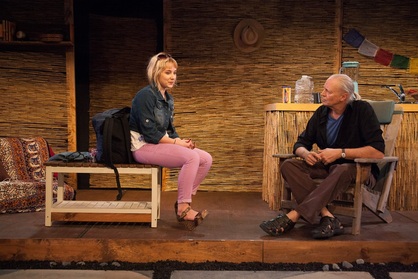I am the costume designer.
How do the costumes in Dancing Lessons reflect the lives of their respective characters?
Clothes communicate so much about us on so many levels, from connotations we chose to those that come across unintentionally. For instance, Senga was once successful even though she is now deeply depressed. Her apartment is a bright colorful reminder of who she was, and the clothes are also from her past life. She wears her most comfortable clothes but it is the fact that she stays in pajamas that tells the story. The actress Cael brought edginess to the character that added another dimension to her character’s anger. I supported this direction by choosing to allow her to wear her nose ring and other piercings, and bold haircut. However, I did not trim or maintain the hairstyle to reflect how the character has been neglecting her body.
What questions did you ask yourself early on when designing costumes for a show?
What story am I helping to tell? What can I communicate about each of the characters in the choices that I make? Designing a contemporary show depends on collaboration with the actors, so the first step was getting to know each of the actors and seeing what elements of themselves, if any, they were going to incorporate into the character. I needed to know their way into the play—what they felt was the core of the character.
Above all I needed to understand Asperger’s and what that can mean for an individual’s relation to their clothes. Most importantly, I have learned there are no rules, as each person is different. The text offers me some rules: he hates skin to skin contact. One of his tics is adjusting his glasses. I had to ask myself: what about his clothes protects him from the world? Would he choose a sweater that was too large so he could pull the sleeves over the hand to avoid a painful touch on the subway? Was there someone who advised him in his clothes at some point and now he only purchases that one style and brand?
Did the designs end up changing much from what you had originally planned?
The designs evolved with the actor’s process. As Andy grew into his character, Ever, and discovered how Ever relates to his world and his tics I began to make choices that would support those decisions. I really appreciated this design collaboration in that Cristina built things into moments—every choice became a part of the story.
The biggest design question was the final moment, which is best not to give away! What kind of formalwear does Ever wear? Does he take it too far and rent a tails instead of a tux? We ended up going with the tails as a moment to allow him to make a wrong social choice. For a person who has to study social situations and people, sometimes he shouldn’t get it right.
What do you like about Dancing Lessons?
I was immediately charmed by the piece. It’s humorous but full of substance. I think it is a beautiful story about how we all approach the world with the brain we have, each of us with different abilities and limitations.
Why do you believe theatre is important?
Theatre is important because storytelling is important. Storytelling is a way of learning empathy, even for those of us who don’t need to study to be ‘neurotypical.’





